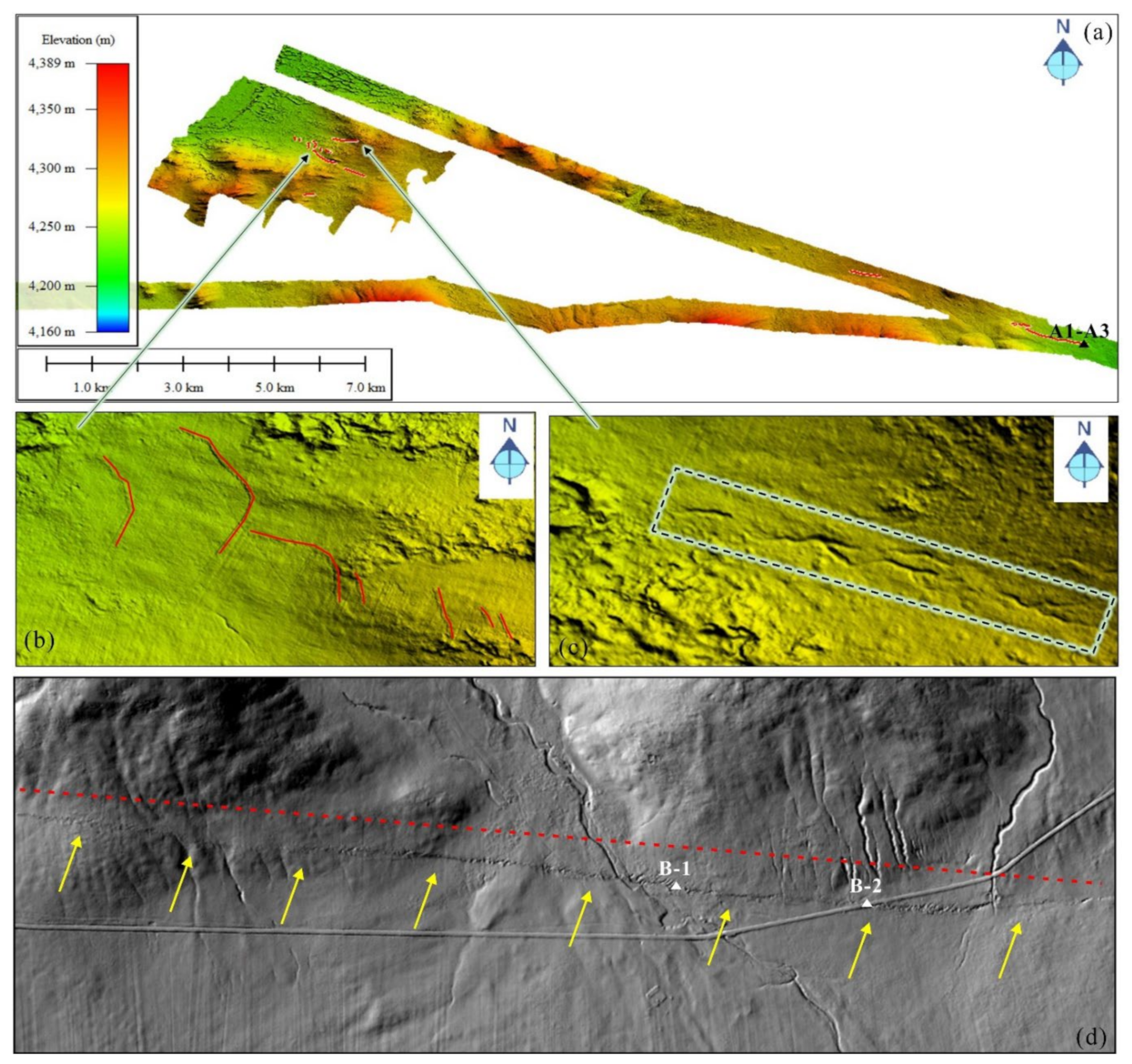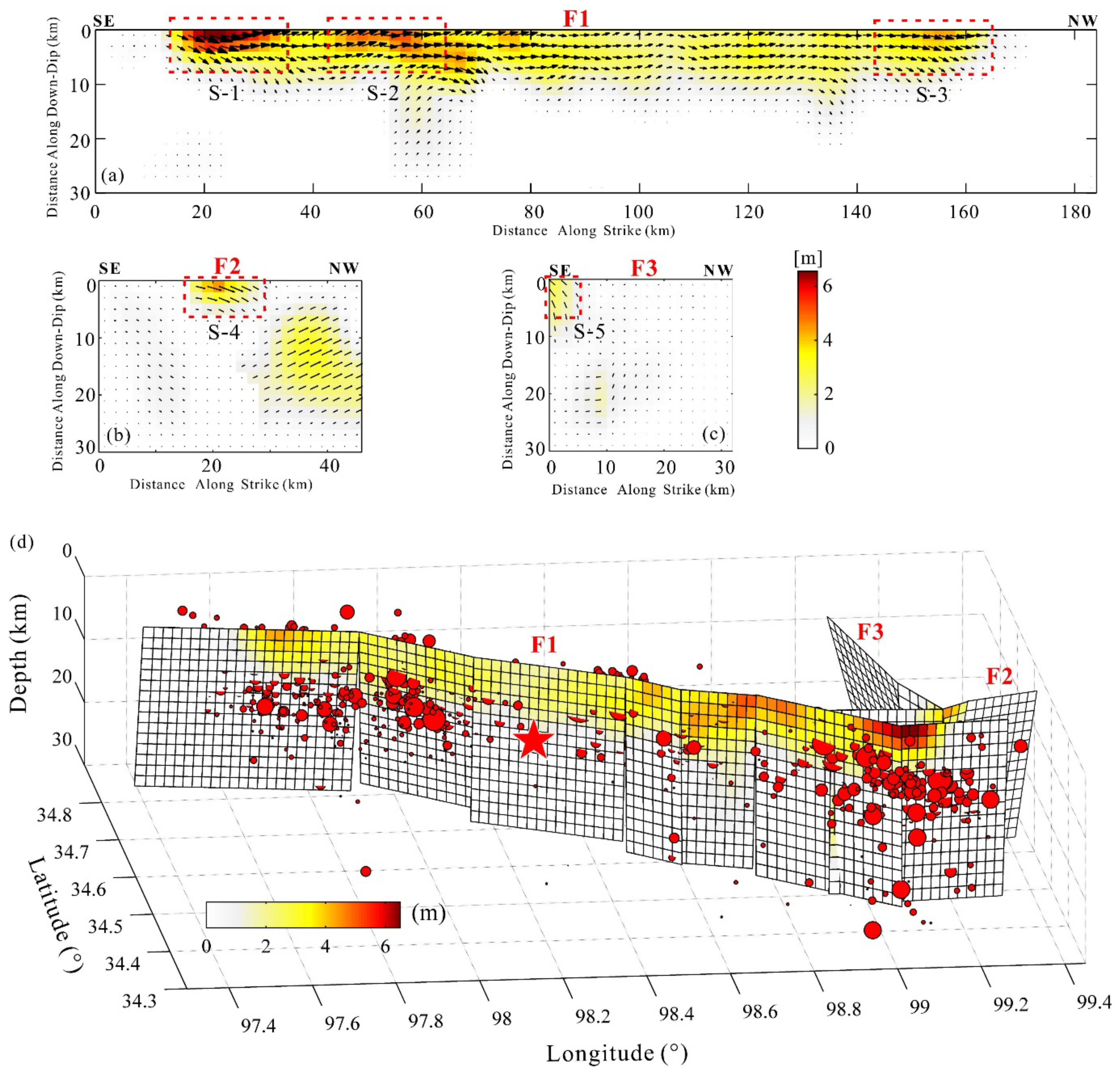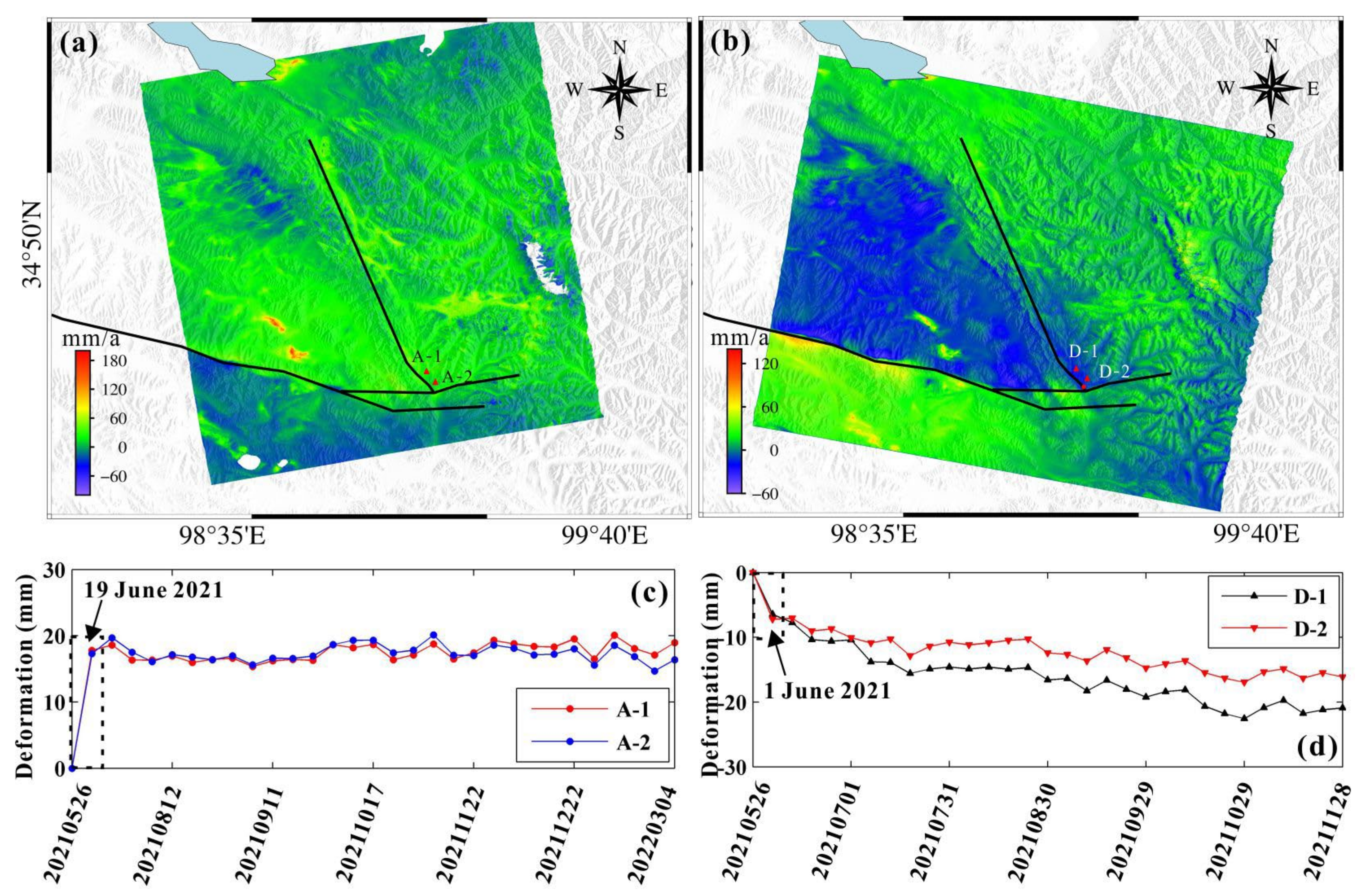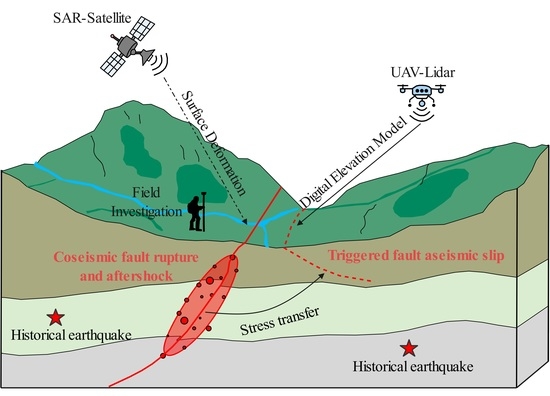Source Model and Triggered Aseismic Faulting of the 2021 Mw 7.3 Maduo Earthquake Revealed by the UAV-Lidar/Photogrammetry, InSAR, and Field Investigation
Abstract
1. Introduction
2. Datasets and Processing
2.1. SAR Images and Interference
2.2. UAV-Lidar Measurement
3. Methodology
3.1. Estimating the Faulting Model Based on InSAR Measurement
3.2. Calculation of the Coulomb Failure Stress Change
4. Results
4.1. Co-Seismic Surface Deformation Field of the 2021 Maduo Earthquake
4.2. Fault Trace Detection and Field Investigation
4.3. The Estimated Faulting Model of the 2021 Maduo Earthquake
5. Discussion
5.1. Bifurcation of Fault Slip in the Southeast End of the Seismic Zone
5.2. Post-Seismic Deformation and Triggered Aseismic Slip along the Changmahe Fault
5.3. Coulomb Stress Change of the Kunlun Fault due to the Maduo Earthquake and Historical Events
6. Conclusions
Supplementary Materials
Author Contributions
Funding
Data Availability Statement
Conflicts of Interest
References
- Chen, H.; Qu, C.; Zhao, D.; Ma, C.; Shan, X. Rupture kinematics and co-seismic slip model of the 2021 Mw 7.3 Maduo (China) earthquake: Implications for the seismic hazard of the Kunlun fault. Remote Sens. 2021, 13, 3327. [Google Scholar] [CrossRef]
- He, K.; Wen, Y.; Xu, C.; Zhao, Y. Fault geometry and slip distribution of the 2021 Mw 7.4 Maduo, China, Earthquake inferred from InSAR measurements and relocated aftershocks. Seismol. Res. Lett. 2021, 93, 8–20. [Google Scholar] [CrossRef]
- Liu, J.; Hu, J.; Li, Z.; Ma, Z.; Zhu, J. Complete three-dimensional coseismic displacements due to the 2021 Maduo earthquake in Qinghai Province, China from Sentinel-1 and ALOS-2 SAR images. Sci. China Earth Sci. 2021, 65, 687–697. [Google Scholar] [CrossRef]
- Zhao, D.; Qu, C.; Chen, H.; Shan, X.; Song, X.; Gong, W. Tectonic and geometric control on fault kinematics of the 2021 Mw7.3 Maduo (China) earthquake inferred from interseismic, co-seismic and postseismic InSAR observations. Geophys. Res. Lett 2021, 48, e2021GL095417. [Google Scholar] [CrossRef]
- Wang, W.; He, J.; Wang, X.; Zhou, Y.; Hao, J.; Zhao, L.; Yao, Z. Rupture process models of the Yangbi and Maduo earthquakes that struck the eastern Tibetan Plateau in May 2021. Sci. Bull. 2022, 67, 466–469. [Google Scholar] [CrossRef]
- Du, X.; Zhang, X. Ionospheric Disturbances Possibly Associated with Yangbi Ms6. 4 and Maduo Ms7. 4 Earthquakes in China from China Seismo Electromagnetic Satellite. Atmosphere 2022, 13, 438. [Google Scholar] [CrossRef]
- Jing, F.; Zhang, L.; Singh, R.P. Pronounced Changes in Thermal Signals Associated with the Madoi (China) M7.3 Earthquake from Passive Microwave and Infrared Satellite Data. Remote Sens. 2022, 14, 2539. [Google Scholar] [CrossRef]
- Yang, X.; Zhang, T.B.; Lu, Q.; Long, F.; Liang, M.J.; Wu, W.W.; Gong, Y.; Wei, J.X.; Wu, J. Variation of thermal infrared brightness temperature anomalies in the Madoi earthquake and associated earthquakes in the Tibetan Plateau (China). Front. Earth Sci. 2022, 10, 332. [Google Scholar] [CrossRef]
- Pan, J.; Bai, M.K.; Li, C.; Liu, F.C.; Li, H.B.; Liu, D.L. Coseismic surface rupture and seismogenic structure of the 2021-05-22 Maduo (Qinghai) Ms 7.4 earthquake. Acta Geol. Sin. 2021, 95, 1655–1670. [Google Scholar]
- Zhan, Y.; Liang, M.; Sun, X.; Huang, F.; Zhao, L.; Gong, Y.; Zhang, H.; Jing, H.; Li, C.; Zhang, P.; et al. Deep structure and seismogenic pattern of the 2021.5.22 Madoi (Qinghai) Ms7.4 earthquake. Chin. J. Geophys. 2021, 64, 2232–2252. [Google Scholar] [CrossRef]
- Wang, L.; Li, X.J.; Yang, L.C.; Liu, A.W.; Wang, Y.; Wu, Q.; Wang, N.; Chen, K.; Li, X.X. Earthquake damage characteristics of the Maduo Mss7.4 earthquake in Qinghai Province. J. Basic Sci. Eng. 2021, 1–10. Available online: https://kns.cnki.net/kcms/detail/11.3242.TB.20210615.1759.002.html (accessed on 30 December 2021).
- Dong, P.; Zhao, B.; Qiao, X. Interaction between historical earthquakes and the 2021 Mw7. 4 Maduo event and their impacts on the seismic gap areas along the East Kunlun fault. Earth Planets Space 2022, 74, 42. [Google Scholar] [CrossRef]
- Yuan, Z.; Li, T.; Su, P.; Sun, H.; Ha, G.; Guo, P.; Thompson Jobe, J. Large Surface-Rupture Gaps and Low Surface Fault Slip of the 2021 Mw 7.4 Maduo Earthquake Along a Low-Activity Strike-Slip Fault, Tibetan Plateau. Geophys. Res. Lett 2022, 49, e2021GL096874. [Google Scholar] [CrossRef]
- Deng, Q.; Zhang, P.; Ran, Y.; Yang, X.; Min, W.; Chu, Q. Basic characteristics of active tectonics of China. Sci. China Ser. D-Earth Sci. 2003, 46, 356–372. [Google Scholar] [CrossRef]
- Kirby, E.; Harkins, N.; Wang, E.; Shi, X.; Fan, C.; Burbank, D. Slip rate gradients along the eastern Kunlun fault. Tectonics 2007, 26, TC2010. [Google Scholar] [CrossRef]
- Zhu, L.; Ji, L.; Liu, C. Interseismic slip rate and locking along the Maqin-Maqu segment of the east Kunlun fault, northern Tibetan Plateau, based on Sentinel-1 images. J. Asian Earth Sci. 2021, 211, 104703. [Google Scholar] [CrossRef]
- Wen, X.; Yi, G.; Xu, X. Background and precursory seismicities along and surrounding the Kunlun fault before the Ms8.1, 2001, Kokoxili earthquake, China. J. Asian. Earth. Sci. 2007, 30, 63–72. [Google Scholar] [CrossRef]
- Li, J.J.; Zhang, J.L.; Cai, Y.Y. Investigation of historical earthquakes, paleo-earthquakes and seismic gap in the eastern Kunlun fault zone. Earthquake 2017, 37, 103–111. (In Chinese) [Google Scholar]
- Xu, D.; Xiao, J.; He, J.; Wang, W. Strong earthquake clustering around the eastern Tibetan Plateau after the 2008 Mw 7.9 Wenchuan earthquake. Sci. China Earth Sci. 2020, 63, 999–1012. [Google Scholar] [CrossRef]
- Yang, X.; Chen, L.; Yang, L.; Li, Y.; Tan, P. Numerical simulation on strong earthquake dynamic process of Bayan Har block. Acta Seismol. Sin. 2013, 35, 304–314. [Google Scholar]
- Li, P.; Liao, L.; Feng, J.; Liu, P. Numerical simulation of relationship between stress evolution and strong earthquakes around the Bayan Har block since 1900. Chinese. J. Geophys. 2019, 62, 4170–4188. [Google Scholar] [CrossRef]
- Liang, M.; Yang, Y.; Du, F.; Gong, Y.; Sun, Y.; Zhao, M.; He, Q. Late quaternary activity of the ce-ntral segment of the Dari fault and restudy of the surface rupture zone of the 1947 M 7¾ Dari earthquake, Qinghai Province. Seismol. Geol. 2020, 42, 703–714. (In Chinese) [Google Scholar] [CrossRef]
- Zhu, Y.; Diao, F.; Yuchao, F.U.; Liu, C.; Xiong, X. Slip rate of the seismogenic fault of the 2021 Maduo earthquake in western China inferred from GPS observations. Sci. China Earth Sci. 2021, 64, 8. [Google Scholar] [CrossRef]
- United States Geological Survey (USGS). M7.3-Southern Qinghai, China. Available online: https://earthquake.u-sgs.gov/earthquakes/eventpage/us7000e54r/executive (accessed on 20 October 2021).
- Jin, Z.; Fialko, Y. Co-seismic and early postseismic deformation due to the 2021 M7. 4 Maduo (China) earthquake. Geophys. Res. Lett. 2021, 48, e2021GL095213. [Google Scholar] [CrossRef]
- Li, Z.; Ding, K.; Zhang, P.; Wen, Y.; Zhao, L.; Chen, J. Coseismic deformation and slip distribution of 2021 Mw 7.4 Madoi earthquake from GNSS observation. Geomat. Inf. Sci. Wuhan Univ. 2021, 46, 1489–1497. (In Chinese) [Google Scholar] [CrossRef]
- Zhang, J.; Xu, L. The centroid moment tensor solution of the 2021 MW7.5 Maduo, Qinghai, earthquake. Acta Seismol. Sin. 2021, 3, 387–391. [Google Scholar] [CrossRef]
- Wang, W.; Fang, L.; Wu, J.; Tu, H.; Chen, L.; Lai, G.; Zhang, L. Aftershock sequence relocation of the 2021 Ms7.4 Maduo Earthquake, Qinghai, China. Sci. China Earth Sci. 2021, 64, 1371–1380. [Google Scholar] [CrossRef]
- Yin, X.X.; Wang, W.H.; Cai, R.; Deng, J.; Ma, L. Precise location of the 2021 Maduo, Qinghai MS 7.4 earthquake and its seismogenic structure. China Earth Eng. J. 2021, 834–839. Available online: https://kns.cnki.net/kcms/detail/62.1208.P.20210625.0932.004.html (accessed on 30 December 2021).
- Ha, G.; Liu, J.; Ren, Z.; Zhu, X.; Bao, G.; Wu, D.; Zhang, Z. The Interpretation of Seismogenic Fault of the Maduo Mw 7.3 Earthquake, Qinghai Based on Remote Sensing Images—A Branch of the East Kunlun Fault System. J. Earth Sci. 2022, 33, 857–868. [Google Scholar] [CrossRef]
- Wegmuller, U.; Werner, C. Gamma SAR processor and interferometry software. In Proceedings of the 3rd ERS Symposium, Space Service Environment (Special Publications 414, ESA), Florence, Italy, 14–21 March 1997; Volume III, pp. 1687–1692. [Google Scholar]
- Jarvis, A.; Reuter, H.I.; Nelson, A.; Guevara, E.; Hole-filled SRTM for the globe Version 4. Retrieved from the CGIAR-CSI SRTM 90m Database. 2008. Available online: http://srtm.csi.cgiar.org (accessed on 26 June 2021).
- Chen, C.W.; Zebker, H.A. Phase unwrapping for large SAR interferograms: Statistical segmentation and generalized network models. IEEE Trans. Geosci. Remote Sens. 2022, 40, 1709–1719. [Google Scholar] [CrossRef]
- Yang, Y.; Chen, Q.; Xu, Q.; Liu, G.; Hu, J. Source model and Coulomb stress change of the 2015 Mw 7.8 Gorkha earthquake determined from improved inversion of geodetic surface deformation observations. J. Geodesy 2019, 93, 333–351. [Google Scholar] [CrossRef]
- Priestnall, G.; Jaafar, J.; Duncan, A. Extracting urban features from LiDAR digital surface models. Comput. Environ. Urban Syst. 2000, 24, 65–78. [Google Scholar] [CrossRef]
- Rayburg, S.; Thoms, M.; Neave, M. A comparison of digital elevation models generated from different data sources. Geomorphology 2009, 106, 261–270. [Google Scholar] [CrossRef]
- Guan, X.; Wu, H. Leveraging the power of multi-core platforms for large-scale geospatial data processing: Exemplified by generating DEM from massive LiDAR point clouds. Comput. Geosci. 2010, 36, 1276–1282. [Google Scholar] [CrossRef]
- Welstead, S.T. Fractal and Wavelet Image Compression Techniques; SPIE Optical Engineering Press: Bellingham, WA, USA, 1999. [Google Scholar] [CrossRef]
- Yang, Y.; Tsai, M.; Hu, J.; Aurelio, M.; Hashimoto, M.; Escudero, J.A.P.; Su, Z.; Chen, Q. Co-seismic slip deficit of the 2017 Mw 6.5 Ormoc earthquake that occurred along a creeping segment and geothermal field of the Philippine fault. Geophys. Res. Lett. 2018, 45, 2659–2668. [Google Scholar] [CrossRef]
- Funning, G.J.; Parsons, B.; Wright, T.J.; Jackson, J.A.; Fielding, E.J. Surface displacements and source parameters of the 2003 Bam (Iran) earthquake from Envisat advanced synthetic aperture radar imagery. J. Geophys. Res.-Sol. Earth 2005, 110, B9. [Google Scholar] [CrossRef]
- Hanks, T.H. Earthquake stress-drops, ambient tectonic stresses, and the stresses that drive plates. Pure Appl. Geophys. 1977, 115, 441–558. [Google Scholar] [CrossRef]
- Stein, R.S. The role of stress transfer in earthquake occurrence. Nature 1999, 402, 605. [Google Scholar] [CrossRef]
- Huang, M.-H.; Tung, H.; Fielding, E.; Huang, H.-H.; Liang, C.; Huang, C.; Hu, J.-C. Multiple fault slip triggered above the 2016 Mw 6.4 MeiNong earthquake in Taiwan. Geophys. Res. Lett. 2016, 43, 7459–7467. [Google Scholar] [CrossRef]
- Okada, Y. Deformation due to shear and tensile faults in a half-space. Bull. Seismol. Soc. Am. 1992, 82, 1018–1040. [Google Scholar] [CrossRef]
- Yang, Y.H.; Hu, J.C.; Chen, Q.; Lei, X.; Zhao, J.; Li, W.; Chiu, C.Y. Shallow slip of blind fault associated with the 2019 M S 6.0 Changning earthquake in fold-and-thrust belt in salt mines of Southeast Sichuan, China. Geophys. J. Int. 2021, 224, 909–922. [Google Scholar] [CrossRef]
- Hsu, Y.J.; Rivera, L.; Wu, Y.M.; Chang, C.H.; Kanamori, H. Spatial heterogeneity of tectonic stress and friction in the crust: New evidence from earthquake focal mechanisms in Taiwan. Geophys. J. Int. 2010, 182, 329–342. [Google Scholar] [CrossRef]
- Jung, H.S.; Won, J.S.; Kim, S.W. An improvement of the performance of multiple-aperture SAR int-erferometry (MAI). IEEE Trans. Geosci. Remote Sens. 2009, 47, 2859–2869. [Google Scholar] [CrossRef]
- Mastro, P.; Serio, C.; Masiello, G.; Pepe, A. The multiple aperture SAR interferometry (MAI) technique for the detection of large ground displacement dynamics: An overview. Remote Sens. 2020, 12, 1189. [Google Scholar] [CrossRef]
- Michel, R.; Avouac, J.P.; Taboury, J. Measuring ground displacements from SAR amplitude images: Application to the Landers earthquake. Geophys. Res. Lett. 1999, 26, 875–878. [Google Scholar] [CrossRef]
- Petricca, P.; Bignami, C.; Doglioni, C. The epicentral fingerprint of earthquakes marks the coseismically activated crustal volume. Earth-Sci. Rev. 2021, 218, 103667. [Google Scholar] [CrossRef]
- Fialko, Y.; Simons, M.; Agnew, D. The complete (3D) surface displacement field in the epicentral area of the 1999 Mw7. 1 Hector Mine earthquake, California, from space geodetic observations. Geophys. Res. Lett. 2001, 28, 3063–3066. [Google Scholar] [CrossRef]
- Haeussler, P.J.; Schwartz, D.P.; Dawson, T.E.; Stenner, H.D.; Lienkaemper, J.J.; Sherrod, B.; Personius, S.F. Surface rupture and slip distribution of the Denali and Totschunda faults in the 3 November 2002 M 7.9 earthquake, Alaska. Bull. Seismol. Soc. Am. 2004, 94, S23–S52. [Google Scholar] [CrossRef]
- Jin, Z.; Fialko, Y. Finite slip models of the 2019 Ridgecrest earthquake sequence constrained by space geodetic data and aftershock locations. Bull. Seismol. Soc. Am. 2020, 110, 1660–1679. [Google Scholar] [CrossRef]
- Lasserre, C.; Peltzer, G.; Crampé, F.; Klinger, Y.; Van der Woerd, J.; Tapponnier, P. Co-seismic deformation of the 2001 Mw = 7.8 Kokoxili earthquake in Tibet, measured by synthetic aperture radar interferometry. J. Geophys. Res.-Sol. Earth 2005, 110, B12. [Google Scholar] [CrossRef]
- Yang, Y.; Chen, Q.; Liu, G.; Cheng, H.Q.; Liu, L.Y.; Hu, J.C. Correction of co-seismic deformation field associated with Wenchuan earthquake with GPS observables and InSAR adjacent track smoothing and fault slip inversion. Chinese. J. Geophys. 2014, 57, 1462–1476. [Google Scholar] [CrossRef]
- Tobita, M.; Nishimura, T.; Kobayashi, T.; Hao, K.X.; Shindo, Y. Estimation of co-seismic deformation and a fault model of the 2010 Yushu earthquake using PALSAR interferometry data. Earth Planet. Sci. Lett. 2011, 307, 430–438. [Google Scholar] [CrossRef]
- Zheng, A.; Yu, X.; Xu, W.; Chen, X.; Zhang, W. A hybrid source mechanism of the 2017 Mw 6.5 Jiuzhaigou earthquake revealed by the joint inversion of strong-motion, teleseismic and InSAR data. Tectonophysics 2020, 789, 228538. [Google Scholar] [CrossRef]
- Yin, X.; Li, X.; Ma, Z.; Yao, S.H.; Gai, H.L.; Xu, W.Y. Characteristics of seismic disasters caused by the Maduo MS7.4 earth-quake in Qinghai Province. China Earth Eng. J. 2021, 1–8. Available online: https://kns.cnki.net/kcms/detail/62.1208.P.20210705.0908.002.html (accessed on 30 December 2021).
- Harris, R.A. Earthquake stress triggers, stress shadows, and seismic hazard. Int. Geo. 2003, 81, 1217–1232. [Google Scholar]
- Tymofyeyeva, E.; Fialko, Y.; Jiang, J.; Xu, X.; Sandwell, D.; Bilham, R.; Moafipoor, S. Slow slip event on the Southern San Andreas fault triggered by the 2017 Mw 8.2 Chiapas (Mexico) earthquake. J. Geophys. Res.-Sol. Earth 2019, 124, 9956–9975. [Google Scholar] [CrossRef]
- Zhao, D.; Qu, C.; Bürgmann, R.; Gong, W.; Shan, X.; Qiao, X.; Liu, L. Large-Scale Crustal Deformation, Slip-Rate Variation, and Strain Distribution along the Kunlun Fault (Tibet) From Sentinel-1 InSAR Observations (2015–2020). J. Geophys. Res. Sol. Earth 2022, 127, e2021JB022892. [Google Scholar] [CrossRef]
- Wessel, P.; Smith, W.H.F. New, improved version of Generic Mapping Tools released. EOS Trans. Am. Geophys. Union 1998, 79, 579. [Google Scholar] [CrossRef]













Publisher’s Note: MDPI stays neutral with regard to jurisdictional claims in published maps and institutional affiliations. |
© 2022 by the authors. Licensee MDPI, Basel, Switzerland. This article is an open access article distributed under the terms and conditions of the Creative Commons Attribution (CC BY) license (https://creativecommons.org/licenses/by/4.0/).
Share and Cite
Yang, Y.-H.; Xu, Q.; Hu, J.-C.; Wang, Y.-S.; Dong, X.-J.; Chen, Q.; Zhang, Y.-J.; Li, H.-L. Source Model and Triggered Aseismic Faulting of the 2021 Mw 7.3 Maduo Earthquake Revealed by the UAV-Lidar/Photogrammetry, InSAR, and Field Investigation. Remote Sens. 2022, 14, 5859. https://doi.org/10.3390/rs14225859
Yang Y-H, Xu Q, Hu J-C, Wang Y-S, Dong X-J, Chen Q, Zhang Y-J, Li H-L. Source Model and Triggered Aseismic Faulting of the 2021 Mw 7.3 Maduo Earthquake Revealed by the UAV-Lidar/Photogrammetry, InSAR, and Field Investigation. Remote Sensing. 2022; 14(22):5859. https://doi.org/10.3390/rs14225859
Chicago/Turabian StyleYang, Ying-Hui, Qiang Xu, Jyr-Ching Hu, Yun-Sheng Wang, Xiu-Jun Dong, Qiang Chen, Yi-Jun Zhang, and Hao-Liang Li. 2022. "Source Model and Triggered Aseismic Faulting of the 2021 Mw 7.3 Maduo Earthquake Revealed by the UAV-Lidar/Photogrammetry, InSAR, and Field Investigation" Remote Sensing 14, no. 22: 5859. https://doi.org/10.3390/rs14225859
APA StyleYang, Y.-H., Xu, Q., Hu, J.-C., Wang, Y.-S., Dong, X.-J., Chen, Q., Zhang, Y.-J., & Li, H.-L. (2022). Source Model and Triggered Aseismic Faulting of the 2021 Mw 7.3 Maduo Earthquake Revealed by the UAV-Lidar/Photogrammetry, InSAR, and Field Investigation. Remote Sensing, 14(22), 5859. https://doi.org/10.3390/rs14225859







